Rewind: What happened to the 2006-07 Carolina Hurricanes?

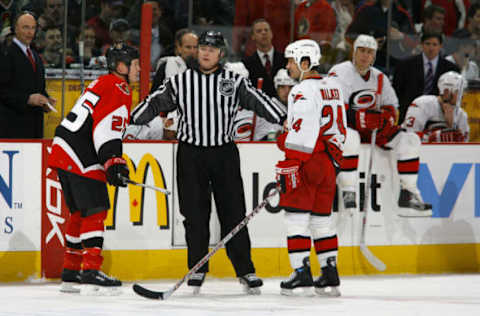
After experiencing the greatest high in professional hockey, the Carolina Hurricanes became the first team in 11 years to miss the playoffs in the season after winning the Stanley Cup. What happened?
This is the tenth installment in my Rewind series, taking a look at the Carolina Hurricanes of seasons past. To check out the prior entries, select a season below:
The result of this season was unexpected, but should it have been? Coming off of the best season in franchise history, the Carolina Hurricanes, who had made the most of the revamped post-lockout NHL, suffered a setback. They still managed to put up 40 wins, though they ultimately fell 4 points out of a playoff spot.
We’re going to change things up with this one as we take a look at what went wrong with Carolina’s Cup defense and the season as a whole. Let’s start by taking a look at some roster changes.
Doug Weight and Mark Recchi, acquired as rentals for a playoff push, departed in the offseason. While keeping one or both would have been nice, that wasn’t part of General Manager Jim Rutherford‘s plan. Neither move came as a surprise, so we move on. Matt Cullen, who picked up 18 points in the Hurricanes’ run to The Cup also departed, signing with the New York Rangers. He was joined by defenseman Aaron Ward.
As free agency opened, the Hurricanes were relatively quiet. They signed former Tampa Bay Lightning netminder John Grahame to back up Cam Ward; the young goalie was slated to become the starter after Martin Gerber signed with the Ottawa Senators.
The team also signed utilitarian winger Trevor Letowski to bolster their forward depth. In another depth move, Rutherford inked big winger Brad Isbister to a one-year contract.
Rutherford also completed a couple of trades before the onset of the season in the hopes of strengthening his team. The first deal took place on July 18 when he sent longtime Hurricane Josef Vasicek to the Nashville Predators for rough and tumble winger Scott Walker.
The second trade drew much more attention as it involved Carolina’s first-round pick from the 2005 draft, Jack Johnson. Frustrated by the promising defenseman’s unwillingness to commit, Rutherford packaged Johnson with fellow rearguard Oleg Tverdovsky and shipped them to the Los Angeles Kings. In return, the Hurricanes received physical defender Tim Gleason as well as center Eric Belanger.
With the roster set, the Hurricanes opened the season as the defending champs.
That sheen wore off quickly.
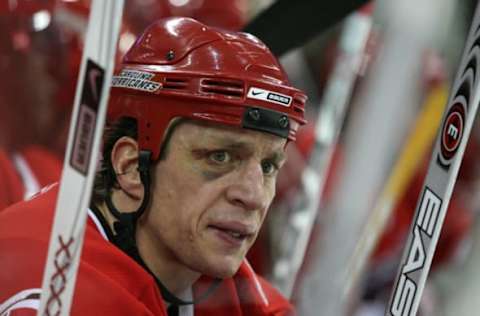
My God, The Inconsistency
The Carolina Hurricanes opened the 2006-07 season with 4 straight losses, being outscored 18-7 in the process. They finally got into the win column thanks to a 4-3 victory over the Atlanta Thrashers and followed that up with two more wins.
The team continued to trade wins and losses before falling into a five-game losing streak that stretched from early to mid-December. Their offense dried up, with Carolina managing just 9 goals during the streak. Their opponents, however, didn’t share this fate as the Hurricanes surrendered 19 goals.
So, how does a team follow up a five-game skid?
With a five-game winning streak, of course.
From the 16th through the 26th of December, the Hurricanes rolled through opponents, racking up 17 goals while surrendering just 8. This, arguably their best stretch of play all season, gave hope that the team could turn things around and shed their inconsistency.
Nope.
The Hurricanes lost 4 of their next 5, including being shut out in consecutive games. They then won 4 out of 5. Rinse, repeat.
Then, on January 8, 2007, Rutherford sent Kevyn Adams to the Phoenix Coyotes in exchange for defenseman Dennis Seidenberg. While Seidenberg was a good defenseman, he did little to help the Hurricanes’ floundering offense.
To address that, Rutherford re-acquired Vasicek from Nashville, sending the ill-fitting Belanger as payment. Two weeks later he shipped a draft pick to Columbus in exchange for winger Anson Carter. While Vasicek eased back into things, Carter saw action in just 10 games, picking up one goal in the process.
Ultimately, the Hurricanes missed the playoffs. They were close, but that just makes it worse. Not only were fans teased with the possibility of making it back, but, by missing so closely, they didn’t secure a high draft pick. Instead, the Hurricanes secured the 11th overall pick, using it to select Brandon Sutter.
The very next pick? Ryan McDonagh.
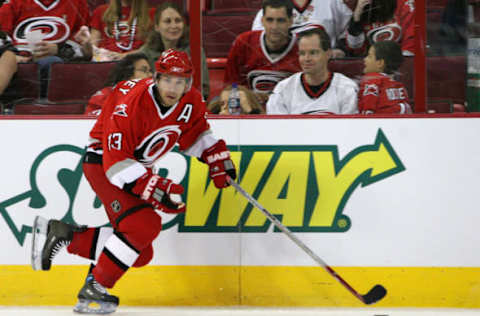
The Offense
Now, the defense and goaltending were far from perfect, however, it is worth noting that the Carolina Hurricanes reduced their goals against by 7 compared to the season before. A huge improvement? No, but it certainly wasn’t the downfall of the team.
So, what was it?
Well, the fact that they scored 53 fewer goals is a pretty big reason. Actually, I think we’ve nailed the problem. While suffering such a scoring dip is catastrophic, there are a couple of things that contributed to this.
Cory Stillman, who put up 21 goals and 55 assists the year before, missed two months after offseason shoulder surgery. Held to just 43 games, Stillman wasn’t able to get himself back up to speed in time, finishing his abbreviated season with 5 goals and 22 assists.
Then there was Eric Staal. I respect Staal and am not here to slag him. The issue is that the Thunder Bay native’s breakout 05-06 season likely set the bar at an unattainable level. Staal followed his 100 point effort with 30 goals and 40 assists. Granted, 70 points is a very respectable total but it was 15 goals and 30 points shy of what he had done. On a team that struggled to score, that made a big difference.
That said, Eric Staal should not bear the brunt of the blame. Frank Kaberle, who had put up 44 points from the blueline the year before, was held to just 27 games. Second-year winger Andrew Ladd didn’t progress quite as well as management hoped for the 2004 4th overall pick.
There were bright spots, primarily with two veteran forwards. Ray Whitney, healthy for the entire season, increased his scoring output by 28 points. He finished second on the team in goals and assists and first overall in total points.
Then there was the captain. Rod Brind’Amour, who put up an incredibly solid 70 points in 05-06, saw his total increase to 82 points, good for second on the team. He led the team in assists and took home the Selke Trophy for best defensive play by a forward for the second consecutive year.
So, let’s take a look at the top scorers and team offensive ranks:
The Hurricanes managed to put up 5 or more goals in 19 games, posting a record of 18-1. When they clicked offensively, they were outstanding. The flip side is that they were held to 2 goals or less in a whopping 35 games and were shut out in 8 of those. Their record? 4-31. Ouch.
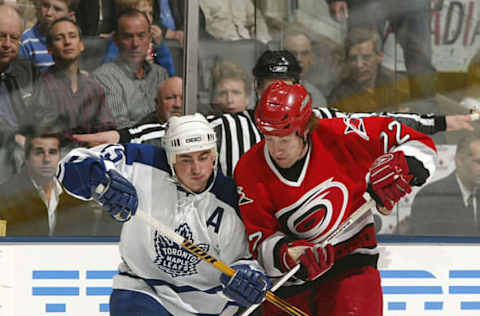
The Defense
While the offense suffered a dramatic setback, the defense did show a small improvement. Mike Commodore was the sole 20 point man on the blueline, a situation made possible by Kaberle missing significant time.
There was also a degree of musical chairs going on, with 10 different defensemen appearing in at least 20 games. It’s also worth noting that, while the Hurricanes did make a bit of headway, they still finished the year in the bottom third in terms of goals against.
Carolina still had a talented group of rearguards but their skillset skewed heavily towards stay at home defensemen, with the likes of Commodore, Gleason, Seidenberg, and Glen Wesley. The 36-year-old Bret Hedican continued to slow down, posting his worst offensive season since joining the Hurricanes in January of 2002.
There’s not really much more to say, so let’s take a look at the ice time leaders and team rankings:
The Hurricanes held opponents to 2 or fewer goals in 33 games, posting a 30-3 record in those contests. Conversely, they allowed 5 or more goals on 13 occasions, going 0-13.
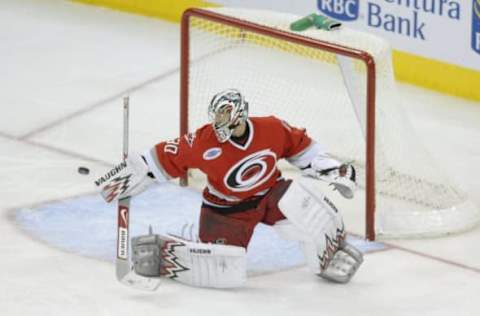
The Goaltending
Cam Ward’s rookie season was a mixed bag, statistically speaking. Yes, he posted a winning record and he became the first rookie netminder to win the Stanley Cup and Conn Smythe since Patrick Roy 20 years earlier. His playoff stats (2.14 GAA, .920 Sv%) were solid, however, they were, well, not good (3.68 GAA, .882 Sv%) during the regular season.
The concern was whether the 22-year-old Ward would hold up in the starter’s role. Rutherford went out and signed veteran John Grahame to solidify the goaltending. The Denver native had spent just over two seasons with Tampa Bay, appearing in 57 games for the Lightning in the 05-06 season.
Where Ward was a relatively unknown commodity, Grahame had spent six seasons in the league. While Grahame’s career numbers at that point (82-66-15, 2.70 GAA, .899Sv%) weren’t particularly impressive, the free-agent goalie class didn’t off much in terms of better options. Well, Rutherford could have thrown money at aging vets like Ed Belfour or Dominik Hasek, but that wasn’t in the cards.
Ward’s transition wasn’t without speed bumps, though he did manage to pick up 30 wins while seeing improvements in his goals-against average and save percentage. He picked up his first career shutout on November 9, turning aside 20 shots from the Washington Capitals. He would shut out Washington again four months later, stopping 25 shots in a 3-0 victory.
Grahame did see a slight improvement in his goals against and save percentage from the previous season, though he failed to post a winning record. While his stats weren’t abysmal, he personified the soft goals at bad times image that the Hurricanes have struggled with for over a decade.
- Cam Ward: 30-21-6, 2.93, .897, 2 SO
- John Grahame: 10-13-2, 2.85, .897, 0 SO
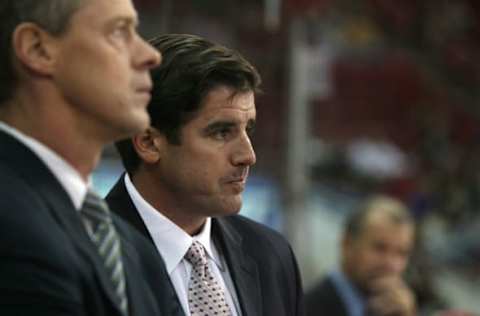
Postmortem
What a mess. Was it the high of winning a Stanley Cup that took this team to such a disappointing season? Was there any way of salvaging that season that could have happened? Was there any way of sparing a Caniac nation spoiled by a winning season?
More from Cardiac Cane
- 2023 Southeast Rookie Showcase: Takeaways from the Canes’ Strong Showing in Florida
- Week Two Coverage Of College Hockey In NC
- Derek Stepan Ends His On Ice Career As A Hurricane
- The Southeast Rookie Showcase Will Be a Good Look at Carolina’s Future
- Noesen Ready To Provide Depth For Canes
While I wonder how many points they could have been eeked out with a healthy Cory Stillman, the 06-07 Carolina Hurricanes were let down most by their defense and goaltending. I won’t single either out since they are so closely intertwined, but shaving just 15 goals allowed off could have given the team a few more wins and a chance to defend their title in the ensuing Stanley Cup playoffs and perhaps rewrite history.
The team would have a long offseason to prepare for the 2007-08 campaign with the goal of returning to the playoffs. With their mix of veterans and young talent, there were pieces that gave fans hope. Would 06-07 prove to be an aberration or an omen of things to come?
Question For CC Readers: Do you think a healthy Stillman would have made enough of a difference for the Hurricanes? Did you have hope for a playoff return or did you see a team whose wheels were coming off?
Next. Analyzing the Impact of Brock McGinn. dark